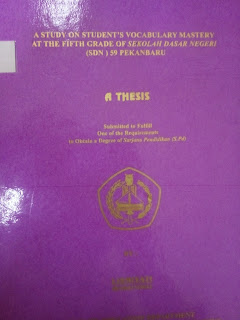Name : Ketlin azura
Class : 4 c (English)
Study : Semantics
Tittle : The study of idioms and its application to ESL and intercultural communicationAuthor : Yoko ItoAffiliation : San Jose State UniversityTopic : Idiom
Rqs :
-Research question :
1.this research question was confirmed as predicted from literature review.
2.this research question was confirmed as predicted.
3.this research question was also confirmed partially.
Methodology : the researcher arranged to collect the data during regularly scheduled meetings of the participants.before the questioner survey,the researcher explained that the purpose of the study was to explore the link between the use of idiom and intercultural relationship,provided intructions for responding to the scale items,and distributed the questioner.
Result : the data were analyses of variance were perform to explore comprehension,ability,perceived interpersonal relationship,generation identification.
Strengthness : the strenghness of the theses can large our knowledge to study about idiom.
Weakness : so many explanation and make me confuse to understand this theses.
Class : 4 c (English)
Study : Semantics
Tittle : The study of idioms and its application to ESL and intercultural communicationAuthor : Yoko ItoAffiliation : San Jose State UniversityTopic : Idiom
Rqs :
-Research question :
1.this research question was confirmed as predicted from literature review.
2.this research question was confirmed as predicted.
3.this research question was also confirmed partially.
Methodology : the researcher arranged to collect the data during regularly scheduled meetings of the participants.before the questioner survey,the researcher explained that the purpose of the study was to explore the link between the use of idiom and intercultural relationship,provided intructions for responding to the scale items,and distributed the questioner.
Result : the data were analyses of variance were perform to explore comprehension,ability,perceived interpersonal relationship,generation identification.
Strengthness : the strenghness of the theses can large our knowledge to study about idiom.
Weakness : so many explanation and make me confuse to understand this theses.














